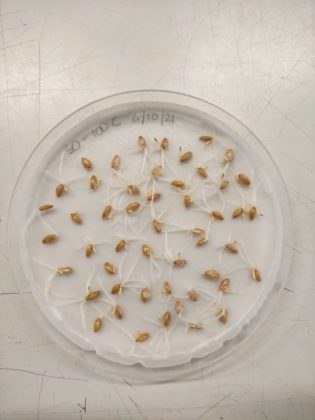Analysing seed germination and emergence data with R
Germination/emergence assays are relatively easy to perform, by following clear and standardised procedures. Most often, we take samples of seeds and we put them in Petri dishes/boxes/pots in some selected conditions (relating to, e.g., humidity content, light and temperature). We inspect those containers according to a tight schedule (e.g., daily) and, at each inspection, we count the number of germinated/emerged seeds and remove them from the containers.

In spite of such simple designs, the process of data analyses may give relevant problems. How should we quantify the time-course of germinations/emergences? How should we compare two (or more) different seed samples? A brief survey of literature shows that a lot of different methods has been used: some of them are ‘traditional’ (e.g., germination indices or linear/nonlinear regression), while some others are relatively new (e.g., methods from survival analysis).
For us, the selection of the most appropriate method can be rather troublesome, especially when we are not fully aware about the basic assumptions that each method makes. We should never forget that selecting the wrong method produces unreliable conclusions. Furthermore, with no clear guidance, different research groups may end up using different methods, which is not necessarily good for the advancement of knowledge. Wouldn’t it be better if we could use the same reliable methods of data analysis, so that we could better understand each other, compare our results and pool them together?

We decided to define a new specific framework for the analysis of germination and emergence data, to encourage the selection of efficient and reliable methods and, lately, improve the communication of results within the scientific community. In this framework, we combined: (i) a step-by-step process, (ii) a set of methods to accomplish it and (iii) a user friendly software interface, based on a new R package. The methods we propose come from the framework of ‘survival analysis’, but they were appropriately modified to serve the specific purposes of germination, emergence and, in general, time-to-event data in weed science and agriculture. These methods have been made available within the drcte package, which depends on the widely known drc package (Ritz et al., 2015), using the same syntax, but providing additional functions and customisation for all types of time-to-event data in agriculture. Furthermore, we also developed the drcSeedGerm package, that contains specific functions and exemplary datasets for seed germination/emergence assays.
Both these packages are presented in a recent manuscript in the Journal Weed Science (Onofri et al., 2022) and they are accompanied by a web tutorial (see at: https://www.statforbiology.com/tags/drcte/), where we give further examples and explanations. Drcte and drcSeedGerm can be freely installed from ‘gitHub’ (Onofri, 2021) and they are actively maintained to improve their effectiveness for all scientists dealing with seed science and technology.
The article, A unified framework for the analysis of germination, emergence, and other time-to-event data in weed science by, Andrea Onofri, Mohsen B. Mesgaran and Christian Ritz is available open access.
References
- https://github.com/ OnofriAndreaPG/drcte. Accessed: February 10, 2022
- Onofri A (2021) Time-to-Event Methods in Agriculture. https://github.com/ OnofriAndreaPG/drcte. Accessed: February 10, 2022
Photos: Credits to Paolo Benincasa, representing germination assays






